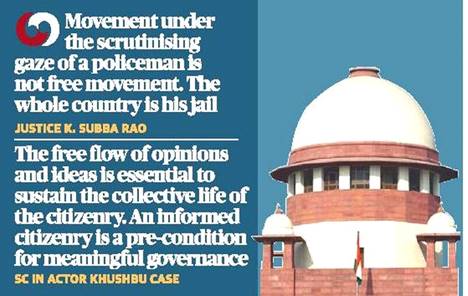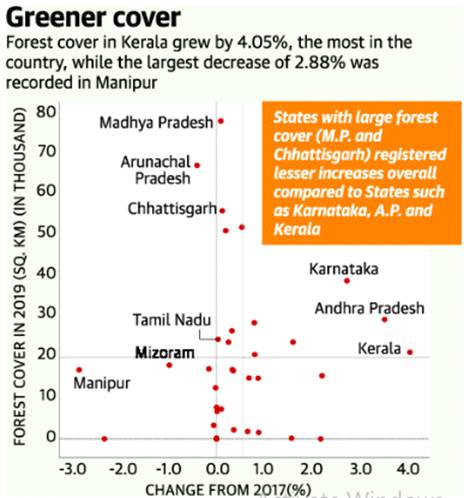



‘Opposing voices can’t be muzzled by force’
POLITY
‘Opposing voices can’t be muzzled by force’
The Supreme Court, in a series of judgments, had recognised dissent as a “symbol of a vibrant democracy” and held that a country becomes a jail if citizens are made to move under the “scrutinising gaze” of the police.

Background information:
- The crackdown by law enforcement authorities against protesters opposing the Citizenship (Amendment) Act and the National Register of Citizens (NRC).
Supreme Court Judgment on free speech:
Bhima-Koregaon case:
- Dissent note observed that individuals who assert causes may be unpopular to the echelons of power are yet entitled to the freedoms which are guaranteed by the Constitution.
- Voices in opposition cannot be muzzled by persecuting those who take up unpopular causes.
- It upheld the view that dissent is a symbol of a vibrant democracy.
Kharak Singh case:
- Dissent note noted that restrictions cannot be imposed on free speech and dissent on the basis of the “personal sensitiveness”.
- Movement under the scrutinising gaze of a policeman is not free movement. The whole country is his jail.
Puttaswamy Judgement:
- Court observed that life are liberty are not bounties conferred by the State”.Shreya Singhal Judgment:
Shreya-Singhal case
- Court observed protected and innocent speech cannot be curtailed on vague grounds that it was grossly offensive or “causes annoyance or inconvenience”.
- What offends, annoys or inconveniences one may not have the same effect on another.
Khushbu Case:
- The free flow of opinions and ideas is essential to sustain the collective life of the citizenry.
- An informed citizenry is a pre-condition for meaningful governance.
Way Forward:
- The right to protest peacefully is enshrined in the Indian Constitution—Article 19(1)(a) guarantees the freedom of speech and expression; Article 19(1)(b) assures citizens the right to assemble peaceably and without arms.
- Article 19(1)(3) says this right is subject to “reasonable restrictions” in the interest of public order. Reasonable restrictions could involve the following:
- If the security of the state is in jeopardy.
- If the friendly relationship we share with a neighbouring country is at stake.
- If public order is disturbed.
- If there is contempt of court.
- If the sovereignty and integrity of India are threatened.
Kerala tops SDG index; Bihar at last rank
Kerala tops states in progress towards UN Sustainable Development Goals, while Bihar is at the bottom of Niti Aayog's SDG Index.
Result of Index:
- Kerala is ranked first in terms of the progress made towards SDG.
- Bihar is at the bottom of the NITI Aayog’s SDG Index.
- Uttar Pradesh, Odisha and Sikkim have shown the most improvement.
- Himachal Pradesh and Sikkim have joined all the southern states in the top tier of front runners who scored more than 65 points.
Positives of Index:
- NITI Aayog has given India an overall score of 60 points, recognizing the major improvements in:
- Affordable and clean energy
- Clean Energy and Sanitation
- Peace, justice and strong institutions
- The Swachh Bharat Mission has contributed largely to the high scores on the sixth SDG — clean water and sanitation.
- Government schemes to provide electricity and cooking gas connections to rural India contributed to progress in the seventh SDG – affordable and clean energy.
Concerns emerging out of Index:
- The second SDG concerning ensuring zero hunger shows a sharp divergence in the performance of States.
- Kerala, Goa and parts of the north-east -- including Mizoram, Nagaland, Arunachal Pradesh and Sikkim – have scored above 65.
- 22 of the states and union territories have scored below 50.
- The central Indian States of Jharkhand, Madhya Pradesh, Bihar and Chhattisgarh have scored below 30, showing abysmal levels of hunger and malnutrition.
- Almost all states have fared poorly in respect of the SDG 5 which talks about achieving gender equality.
- The indicators considered include crimes against women, eradicating sex selection and discrimination against daughters, and access to reproductive health schemes, as well as indicators showing women’s economic and political empowerment and leadership.
- The low sex ratio of 896 females per 1000 males, a 17.5% female labour participation rate, and the fact that one in three women experience violence have contributed to a low score.
About Sustainable Development Goals:
- It is a group of 17 goals with 169 targets and 306 indicators, as proposed by the United Nation General Assembly’s Open Working Group on Sustainable Development Goals to be achieved by 2030.
- The UN has developed 232 indicators to measure compliance by member nations.
SDG in India:
- The NITI Aayog is the coordinating agency for SDG in India.
- To monitor the progress made by the states in terms of the SDG indicators, NITI Aayog has come up with the India SDG index.
- It took into account 16 out of 17 goals specified by the United Nations as SDGs .
- The Index this year ranked states based on 54 targets spread over 100 indicators out of 306 outlined by the UN.
- The first report, which was launched in 2018 had 13 goals and 39 indicators.
ENVIRONMENT
Overall green cover rises, but north-east records dip
The forest cover in the country increased by 3,976 square kilometres (sqkm) but with the sharpest declines in the northeastern States of Arunachal Pradesh, Manipur and Mizoram, according to the 2019 edition of the India State of Forest Report (ISFR).

Forest Cover in India:
- The forest cover in India is measured by Forest Survey of India (an organisation under the Ministry of Environment & Forests, Government of India) since 1987.
- It defines ‘forest cover’ in India as all lands, more than one hectare in area with a tree canopy density of more than 10% irrespective of ownership and legal status.
- Such lands may not necessarily be a recorded forest area.
- It also includes orchards, bamboo and palm.
- At 712,249 sqkm, the forest cover constituted 21.67% of the nation’s geographical area or 0.12% more than last year.
- The ISFR is a biennial exercise which assesses the forest and tree cover, bamboo resources, carbon stock and forest fires.
Report’s Findings:
- The top three states showing an increase in forest cover are Karnataka, Andhra Pradesh and Kerala.
- The forest cover within the Recorded Forest Area (area officially classified by States or the Centre as ‘forest’) showed a 330 sq. km decrease, but ‘forest’ outside such a recorded area increased by 4,306 sq. km.
- The mangrove cover increased by 54 sqkm, or about 1%, from the last assessment, with Gujarat and Maharashtra registering the largest improvements.
- The total bamboo bearing area was estimated to be 160, 037 sqkm and increased by 3,229 sqkm.
- The total carbon stock of the country was estimated at 7124 million tons, which is an increase of 42.6 million tons from the last assessment.
Concerns in findings of the report:
- The report states that the quality of forest cover in India, in terms of the canopy density of the trees comprising forest patches, is wavering.
- 1,755 square kilometres of ‘moderately dense forest’ (MDF) became ‘Very dense forest (VDF) but around 2,782 square kilometres of MDF regressed into lower quality ‘open forest (OF),’ ‘Scrub forest’ or ‘Non-forest.’
About Tree Cover:
- Tree cover is defined as the patches of trees less than 1 hectare and occurring outside the recorded forest area.
- Tree and forest cover together constitute 25.56% of India’s area. It was 24.39% in last assessment.
- The decline in tree cover inside forests is mainly due to the tribal populations getting land titles.
- The rise in trees outside the forest area is mainly due to increased tree plantation and afforestation activities.
- Tree outside forest was found to comprise nearly 29.38 million hectares, which was 36.4% of the total tree and forest cover in the country.
Conclusions:
- India’s tree and forest cover have been in the range of 21-25% over the years.
- In spite of the recent progress, the forest cover still falls short of the target set by the National Forest Policy of 1988, which envisages 33% forest cover in India.
ECONOMY
Carbon tax waiver for coal mooted
Prime Minister office has proposed waiving a tax on coal to help finance pollution-curbing equipment.
Significance of the move:
- Improve the financial health of utilities and distribution companies.
- Help power producers to install pollution-curbing equipment.
- India’s coal industry has been lobbying for government help, citing high debt levels and burgeoning payment dues from government-owned power distribution companies.
Concerns related to the move:
- The proposal would make coal more competitive in price with solar and wind energy.
- It may affect India’s strides in renewable energy as coal energy will become competitive again.
- Indian commitment to Paris agreement would be further affected as coal industry is polluting in nature.
- It may worsen the air pollution gripping Indian cities as coal based thermal power plants emit large and varied (nitrogen oxides, sulfur dioxide, particulate matter (PM), mercury)
Reference: https://www.thehindu.com/business/Industry/carbon-tax-waiver-for-coal-mooted/article30436219.ece
SECURITY
AFSPA extended in Nagaland
The Ministry of Home Affairs (MHA) has declared the entire State of Nagaland as a “disturbed area” for six more months, under the controversial Armed Forces (Special Powers) Act (AFSPA).
About AFSPA in Nagaland:
- The AFSPA has been in force in the Northeast since 1958.
- Armed Forces (Special Powers) Act (AFSPA) empowers security forces to conduct operations anywhere and arrest anyone without prior notice.
- In exercise of the powers conferred by Section 3 of the Armed Forces (Special Powers) Act, 1958 the central government via the Ministry of Home Affairs (MHA) has declared the whole State of Nagaland to be a ‘disturbed area’ for a period of six months with effect from December 30, 2019.
- The reason stated for the extension has been that the area comprising the whole state of Nagaland is in such a “disturbed and dangerous condition” that the use of armed forces in aid of the civil power is necessary.
About AFSPA:
- Search, seizure or arrest of anyone or any premise without a warrant.
- No inquiry against the members of armed forces for violation of human rights without the permission of central govt.
- Gathering of more than 5 people can be dispersed by armed forces using the force. (peaceful or violent: non mention of it).
- People residing in the Afspa enacted areas need the permission of central govt in order to approach SC for constitutional remedies under art 32.
Reference: https://www.thehindu.com/news/national/other-states/afspa-extended-in-nagaland/article30434509.ece

© 2025 iasgyan. All right reserved